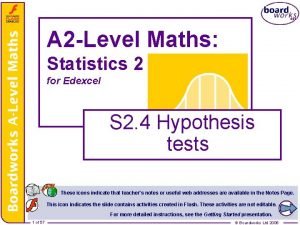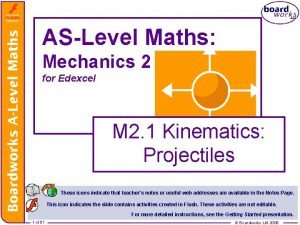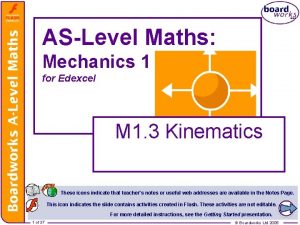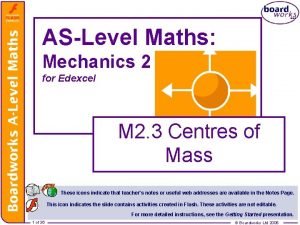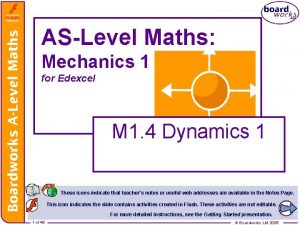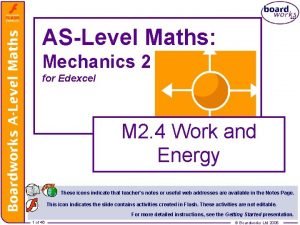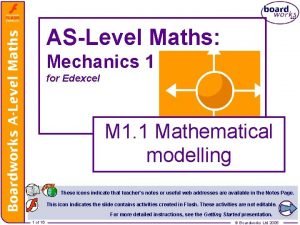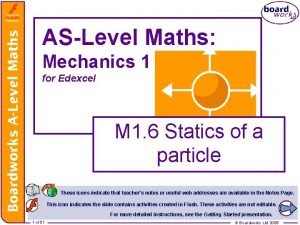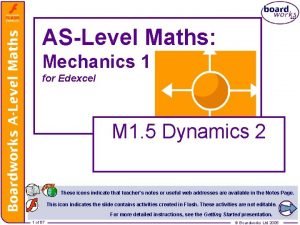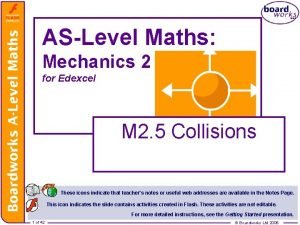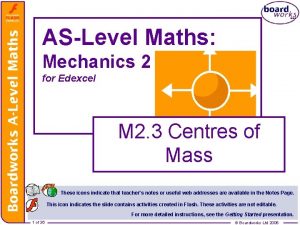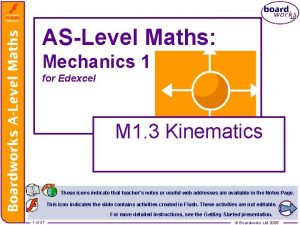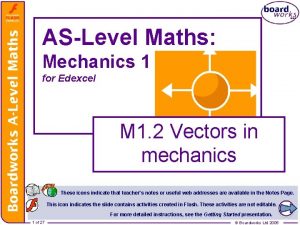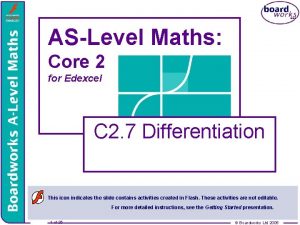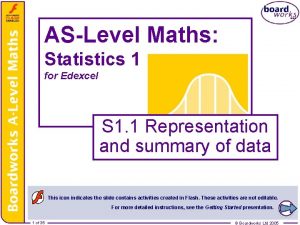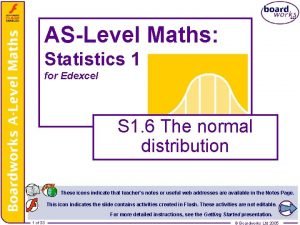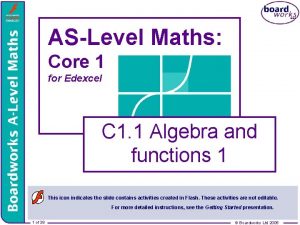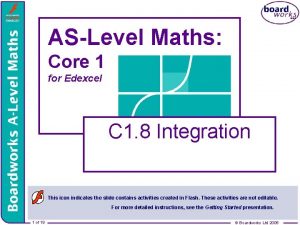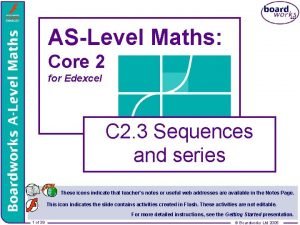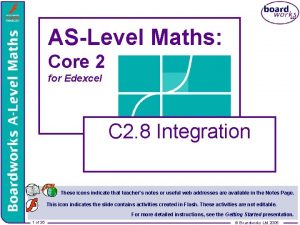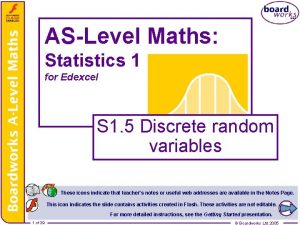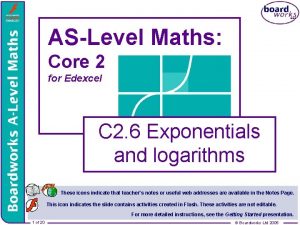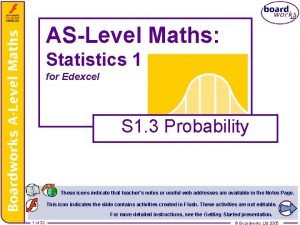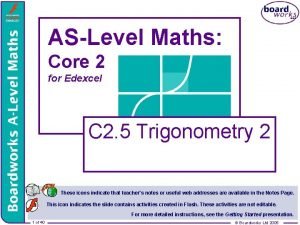ASLevel Maths Mechanics 1 for Edexcel M 1




































- Slides: 36

AS-Level Maths: Mechanics 1 for Edexcel M 1. 7 Moments These icons indicate that teacher’s notes or useful web addresses are available in the Notes Page. This icon indicates the slide contains activities created in Flash. These activities are not editable. For more detailed instructions, see the Getting Started presentation. 1 of 36 © Boardworks Ltd 2005

Contents Calculating moments Uniform and non-uniform rods Tilting Examination-style questions 2 of 36 © Boardworks Ltd 2005

Moments The moment of a force is a measure of the force’s capacity to rotate an object around a fixed point (pivot) or axis. Moment = Force × Perpendicular distance ‘Perpendicular distance’ refers to the perpendicular distance between the line of action of the force and the centre of the rotation. The moment of a force is measured in Newton-metres (Nm). 3 of 36 © Boardworks Ltd 2005

Adding and subtracting moments Moments can act in a clockwise or anti-clockwise direction. ↻ is used to represent clockwise and ↺, anti-clockwise. If two or more moments are acting on an object, the overall moment is the difference between the total clockwise moment and the total anti-clockwise moment. If an object is in equilibrium then: total clockwise moments = total anti-clockwise moments 4 of 36 © Boardworks Ltd 2005

Calculating moments Calculate the moment about A for each of the following forces: 3 N 5 N 5 m A A Moment =3 N× 5 m = 15 Nm ↻ 5 of 36 The moment is zero since the perpendicular distance is zero. © Boardworks Ltd 2005

Calculating moments Calculate the sum of the moments about A for each diagram. 2 N 3 N 2 m A 3 m A 5 N ↻ moment ↺ moment 1 m 4 N =3 N× 2 m = 6 Nm =5 N× 3 m = 15 Nm Resultant moment = 15 Nm – 6 Nm = 9 Nm ↺ 6 of 36 6 m Both forces are acting in a clockwise direction. Resultant moment = (2 × 6) + (4 × 1) = 16 Nm ↻ © Boardworks Ltd 2005

Non-perpendicular forces If the distance given is not perpendicular to the force, you can use trigonometry to work out the perpendicular distance. C 2 m F A B Force F is not perpendicular to its given distance to X. The line AB is. You can work out the component of F that is exerted in the direction AB. The component of force F in the direction AB is equal to the magnitude of F, multiplied by the cosine of the angle between the force and the direction AB. The component of the force in the direction AB = Fcos. The component of the force in the direction AC = Fcos(90 - ) = Fsin. 7 of 36 © Boardworks Ltd 2005

Calculating moments questions For each of the following diagrams, calculate the sum of the moments about A. Remember to state whether the resulting moments are acting in a clockwise or anti-clockwise direction. 1. 2. 5 N 8 N 30 o 3 m A 4 m 4 m A 6 m 7 N 5 N 8 of 36 © Boardworks Ltd 2005

Calculating moments solutions 1. The 5 N force is acting in a clockwise direction and the 8 N force is acting in an anti-clockwise direction. ↻ moment = 5 N × 3 m = 15 Nm ↺ moment = 8 N × 4 m = 32 Nm Resultant moment = 32 Nm – 15 Nm = 17 Nm ↺ 2. The 5 N force is acting in an anti-clockwise direction whilst the 7 N force is acting in a clockwise direction. ↺ moment = 5 N × 4 m = 20 Nm ↻ moment = 7 sin 30° N × 6 m = 21 Nm Resultant moment = 21 Nm – 20 Nm = 1 Nm ↻ 9 of 36 © Boardworks Ltd 2005

Calculating moments questions 4. 3. 9 N 10 N 12 N 2 m A A 2 m 1 m 50 o 3 m 3 m 8 N 10 of 36 10 N © Boardworks Ltd 2005

Calculating moments solutions 3. Both forces are acting in a clockwise direction. ↻ moments = (10 N × 2 m) + (8 N × 2 m) = 20 Nm + 16 Nm Resultant moment = 36 Nm ↻ 4. The 9 N and 10 N forces are acting in a clockwise direction. The 12 N force is acting in an anti-clockwise direction. ↻ moments = (9 N × 1 m) + (10 N × 3 m) = 9 Nm + 30 Nm = 39 Nm ↺ moment = 12 sin 50 o N × 3 m = 27. 6 Nm (to 3 s. f. ) Resultant moment = 39 Nm – 27. 6 Nm = 11. 4 Nm ↻ (to 3 s. f. ) 11 of 36 © Boardworks Ltd 2005

Contents Uniform and non-uniform rods Calculating moments Uniform and non-uniform rods Tilting Examination-style questions 12 of 36 © Boardworks Ltd 2005

Rods If a rod is uniform, then its weight can be taken to act at the mid-point of the rod. If a rod is pivoted at a point, then there will be a reaction force at this point. If a rod is resting on two or more supports, then there will be reaction forces (not necessarily equal) at these points. 13 of 36 © Boardworks Ltd 2005

Light uniform rods A light rod may have a mass so small compared to the masses acting on it, that its own mass can be ignored. 1. The light rod shown below is in equilibrium. Calculate the size of the force X and the value of d. Resolving forces vertically: X+6=9 so, X = 3 9 A X 14 of 36 d B 1 C 6 Taking moments about C 9 × 1 = 3(d + 1) 9 – 3 = 3 d 2=d © Boardworks Ltd 2005

Uniform rod questions 2. A uniform rod AB has mass of 6 kg and is pivoted at C. The length of the rod is 10 m and distance AC = 4 m. Calculate the mass of the weight that must be attached at A to keep the rod in equilibrium. R A mg N 4 C 5 1 B Taking moments about C: m× 4=6× 1 4 m = 6 m = 1. 5 6 g N Therefore, the mass of the weight that must be attached at A is 1. 5 kg. 15 of 36 © Boardworks Ltd 2005

Uniform rod questions 3. A uniform rod AB has length of 6 m and mass of 12 kg. A weight of mass 8 kg is attached at A and a weight of mass 10 kg is attached at B. The beam is pivoted at C and is in equilibrium. Find the distance AC. R A 8 g N 3 d C 12 g N 3 -d B 10 g N Taking moments about C: ↻ moment = 10 × (3 – d) = 30 – 10 d ↺ moment = 8 × (3 + d) + 12 d = 24 + 8 d + 12 d = 24 + 20 d So, 30 – 10 d = 24 + 20 d 6 = 30 d The distance AC = 3. 2 m d = 0. 2 m 16 of 36 © Boardworks Ltd 2005

Uniform rod questions 4. A uniform beam AB of mass 10 kg is 8 m long and is resting on two supports at A and B. A mass of 20 kg is placed on the beam 1 m from A. A mass of 15 kg is placed on the beam 2 m from B. Calculate the reaction forces at A and B. R 2 R 1 A 3 1 20 g N 2 15 g N B Resolving forces vertically: R 1 + R 2 = 45 g N Taking moments about A: 20 × 1 + 10 × 4 + 15 × 6 = R 2 × 8 150 = 8 R 2 = 18. 75 g N (183. 75 N) So, R 1 = 45 – R 2 = 45 – 18. 75 = 26. 25 g N (257. 25 N) 17 of 36 © Boardworks Ltd 2005

Non-uniform rod questions The centre of mass of a non-uniform rod is not necessarily at the rod’s mid-point. 1. A non-uniform beam AB of length 6 m and mass 5 kg rests on a pivot at the mid-point C. When a mass of 2 kg rests on the beam 1. 5 m from B, the system is in equilibrium. Find the distance between A and the centre of mass of the beam. R A d 3 -d 5 g N C 1. 5 2 g N B Taking moments about C: 5 × (3 – d) = 2 × 1. 5 15 – 5 d = 3 So, 5 d = 12 d = 2. 4 m Therefore, the centre of mass of the beam is 2. 4 m from A. 18 of 36 © Boardworks Ltd 2005

Non-uniform rod questions 2. A non-uniform rod AB has length 8 m and mass 5 kg. It is resting on two supports at C and D, where C is 1 m from A and D is 2 m from B. The reaction force at C is a third of that at D. Calculate the distance between A and the centre of mass of the rod. 3 R R A 1 C d 5 -d D 2 B Resolving vertically: 4 R = 5 g N R = 1. 25 g N Taking moments about D: 5 R = 5(5 – d) 6. 25 = 25 – 5 d 5 d = 18. 75 So, the centre of mass d = 3. 75 m is 4. 75 m from A. 5 g N 19 of 36 © Boardworks Ltd 2005

Non-uniform rod questions 3. A non-uniform rod AB of length 6 m and mass 3 kg, has its centre of mass 2 m from A. It is suspended from the ceiling by two vertical strings attached at C and D, where C is 0. 5 m from A and D is 1. 5 m from B. Calculate the tension in the strings at C and D. T 2 T 1 C A 0. 5 1. 5 D 2. 5 1. 5 B Resolving forces vertically: T 1 + T 2 = 3 g N Taking moments about C: 3 × 1. 5 = T 2 × 4 4 T 2 = 4. 5 So, the tension in the string T 2 = 1. 125 g N at C is 1. 875 g N (18. 375 N) So, T 1 = 1. 875 g N and the tension in the string at D is 1. 125 g N (11. 025 N) 3 g N 20 of 36 © Boardworks Ltd 2005

Contents Tilting Calculating moments Uniform and non-uniform rods Tilting Examination-style questions 21 of 36 © Boardworks Ltd 2005

Tilting If a rod is resting on two supports at A and B and is on the point of tilting about A, then the reaction force at B is 0. 22 of 36 © Boardworks Ltd 2005

Tilting questions 1. A 9 m uniform rod AB is resting on two supports at C and D, where C is 1. 5 m from A and D is 3. 5 m from B. The mass of the rod is 3 kg. A mass of 1 kg is attached to the rod so that the rod is on the point of tilting about D. Find the distance from A where this mass should be placed. R 1 A 1. 5 C R 2 3 1 3 g N D d B 3. 5 -d 1 g N When the rod is about to tilt: R 1 = 0 Taking moments about D: 3× 1=1×d 3 = 1 d d=3 m Therefore the 1 kg mass should be placed 8. 5 m from A. 23 of 36 © Boardworks Ltd 2005

Tilting questions 2. A uniform rod AB of length 10 m and weight 3 N rests on two supports at B and C, where C is 1 m from A. A weight of 5 N is attached to the rod 2 m from A. Given that when a load is attached 0. 5 m from A, the rod is on the point of tilting about C, find the weight of this load in Newtons. R 1 A 0. 5 W C R 2 1 3 5 N 3 N 5 B Taking moments about B: 0. 5 W = 5 × 1 + 3 × 4 0. 5 W = 17 W = 34 N Therefore the load must have a weight of 34 N. 24 of 36 © Boardworks Ltd 2005

Tilting questions 3. A non-uniform rod AB of length 6 m and mass 4 kg is resting on two supports C and D, where C is 1 m from A and D is 2 m from B. When a mass of 5 kg is attached at a point 0. 8 m from B, the rod is on the point of tilting about D. Calculate the distance between A and the centre of mass of the rod. R 1 A 1 C R 2 3 -d 4 g N d D 1. 2 0. 8 5 g N B Taking moments about D: 4 × d = 5 × 1. 2 4 d = 6 d = 1. 5 m Therefore the centre of mass of the rod is 2. 5 m from A. 25 of 36 © Boardworks Ltd 2005

Contents Examination-style questions Calculating moments Uniform and non-uniform rods Tilting Examination-style questions 26 of 36 © Boardworks Ltd 2005

Examination-style question 1 1. A footbridge across a stream consists of a tree trunk of length 6 m and mass 100 kg, supported at the ends A and B. 2. A child of mass 40 kg is standing at a point C on the footbridge. 3. Given that the magnitude of the force exerted by the support at A is two thirds of the magnitude of the force exerted by the support at B, calculate; 4. a) the magnitude, in Newtons of the force exerted by the support at A, b) the distance AC. 27 of 36 © Boardworks Ltd 2005

Solution 1 a) Resolving forces vertically: R A d 3 100 g N C 3 -d 40 g N B 5 R = 140 g N 3 R = 84 g N Force at A = So, the force exerted by the support at A = 56 g N 56 × 9. 8 = 548. 8 N b) Taking moments about A: (100 × 3) + 40(3 + d) = 84 × 6 300 + 120 + 40 d = 504 40 d = 84 d = 2. 1 m Therefore the distance AC is 5. 1 m. 28 of 36 © Boardworks Ltd 2005

Examination-style question 2 2. A non-uniform rod AB has length 4 m and weight 100 N. The rod rests horizontally on two supports C and D, where C is 1 m from A and D is 0. 5 m from B. The centre of mass of the rod is d m from A. 3. An object of weight W Newtons is placed at B. The magnitude of the reaction force on the rod at D is now 150 N. a) Show that 100 d + 3 W = 475 The object is now moved from B and placed at A. The rod remains in equilibrium and the magnitude of the reaction force at D is now 60 N. b) Write another equation connecting W and d, and hence calculate W and d. 29 of 36 © Boardworks Ltd 2005

Solution 2 150 N R 1 1 A 0. 5 C D a) Taking moments about C: B 100 d – 100 + 3 W = 375 100 N WN d 0. 5 1 A C W D 100 N So, 100 d + 3 W = 475 b) Taking moments about C: 60 N R 1 100 × (d – 1) + 3 W = 150 × 2. 5 B 100 × (d – 1) = 1 W + 60 × 2. 5 100 d – 100 = W + 150 So, 100 d – W = 250 d Solving simultaneously: W = 56. 25 N and d = 3. 06 m (3 s. f. ). 30 of 36 © Boardworks Ltd 2005

Examination-style question 3 3. A heavy uniform steel rod AB has length 12 m. A particle of weight 100 N is placed at A and a particle of weight 200 N is placed at B. The rod is attached to the ceiling by two steel cables at C and D where C is 2 m from A and D is 3. 5 m from B. The tension in the cable at D is twice the tension in the cable at C. a) Calculate the tension in the cable at C and state any assumptions that you have made. b) Calculate the weight of the steel rod. 31 of 36 © Boardworks Ltd 2005

Solution 3 2 T 3. 5 T A 2 2. 5 4 D C 100 N W B 200 N a) Taking moments about the centre of the rod: 2 T × 2. 5 + 100 × 6 = T × 4 + 200 × 6 5 T + 600 = 4 T + 1200 So, T = 600 N Therefore, the tension in the cable at C is 600 N. It was assumed that the steel cables were light and inextensible. b) Resolving forces vertically: 600 + 1200 = 100 + W + 200 c) 1800 = 300 + W d) So, W = 1500 N Therefore the steel rod has a weight of 1500 N. 32 of 36 © Boardworks Ltd 2005

Examination-style question 4 4. A log AB of length 10 m is placed on two smooth supports at C and D where C is 1 m from A and D is 2 m from B. When a force of 600 N is applied to the log vertically upwards at A, the log is on the point of tilting about D. Initially, the log is modelled as a uniform rod. a) Calculate an estimate of the weight of the log. The force at A is now removed and a force of 750 N is applied to the log vertically upwards at B. The log is now on the point of tilting about C. b) Remodelling the log as non-uniform, calculate a revised estimate of the weight of the log. 33 of 36 © Boardworks Ltd 2005

Solution 4 a 600 N R 1 A 1 C R 2 3 4 D 2 B W Taking moments about D: 600 × 8 = 3 W 3 W = 4800 W = 1600 N Remember: R 1 = 0 Therefore an estimate of the weight of the log is 1600 N. 34 of 36 © Boardworks Ltd 2005

Solution 4 b R 2 R 1 A 1 C d 7–d D 750 N 2 B Taking moments about C: W × d = 750 × 9 Wd = 6750 W 600 N R 1 A 1 C R 2 d 7 -d D 2 B Taking moments about D: 600 × 8 = W × (7 – d) 7 W – Wd = 4800 W 35 of 36 © Boardworks Ltd 2005

Solution 4 b Solving simultaneously gives: So, W = 1650 Therefore, a revised estimate of the weight of the log is 1650 N. 36 of 36 © Boardworks Ltd 2005
 Pie chart question
Pie chart question Hypothesis testing a level maths
Hypothesis testing a level maths Nationell inriktning för artificiell intelligens
Nationell inriktning för artificiell intelligens Tillitsbaserad ledning
Tillitsbaserad ledning Kanaans land
Kanaans land Nyckelkompetenser för livslångt lärande
Nyckelkompetenser för livslångt lärande Ro i rom pax
Ro i rom pax Gibbs reflekterande cykel
Gibbs reflekterande cykel Ledningssystem för verksamhetsinformation
Ledningssystem för verksamhetsinformation Matematisk modellering eksempel
Matematisk modellering eksempel Shivaiter
Shivaiter Centrum för kunskap och säkerhet
Centrum för kunskap och säkerhet Adressändring ideell förening
Adressändring ideell förening Verktyg för automatisering av utbetalningar
Verktyg för automatisering av utbetalningar Cellorov
Cellorov Bo bergman jag fryser om dina händer
Bo bergman jag fryser om dina händer Inköpsprocessen steg för steg
Inköpsprocessen steg för steg Strategi för svensk viltförvaltning
Strategi för svensk viltförvaltning Varians
Varians Datorkunskap för nybörjare
Datorkunskap för nybörjare Tack för att ni har lyssnat
Tack för att ni har lyssnat Klassificeringsstruktur för kommunala verksamheter
Klassificeringsstruktur för kommunala verksamheter Returpilarna
Returpilarna Läkarutlåtande för livränta
Läkarutlåtande för livränta Påbyggnader för flakfordon
Påbyggnader för flakfordon Tack för att ni lyssnade
Tack för att ni lyssnade Egg för emanuel
Egg för emanuel Tack för att ni har lyssnat
Tack för att ni har lyssnat Rutin för avvikelsehantering
Rutin för avvikelsehantering Meios steg för steg
Meios steg för steg Verifikationsplan
Verifikationsplan Tidbok
Tidbok Iso 22301 utbildning
Iso 22301 utbildning Myndigheten för delaktighet
Myndigheten för delaktighet Presentera för publik crossboss
Presentera för publik crossboss Rbk-mätning
Rbk-mätning Kung dog 1611
Kung dog 1611

